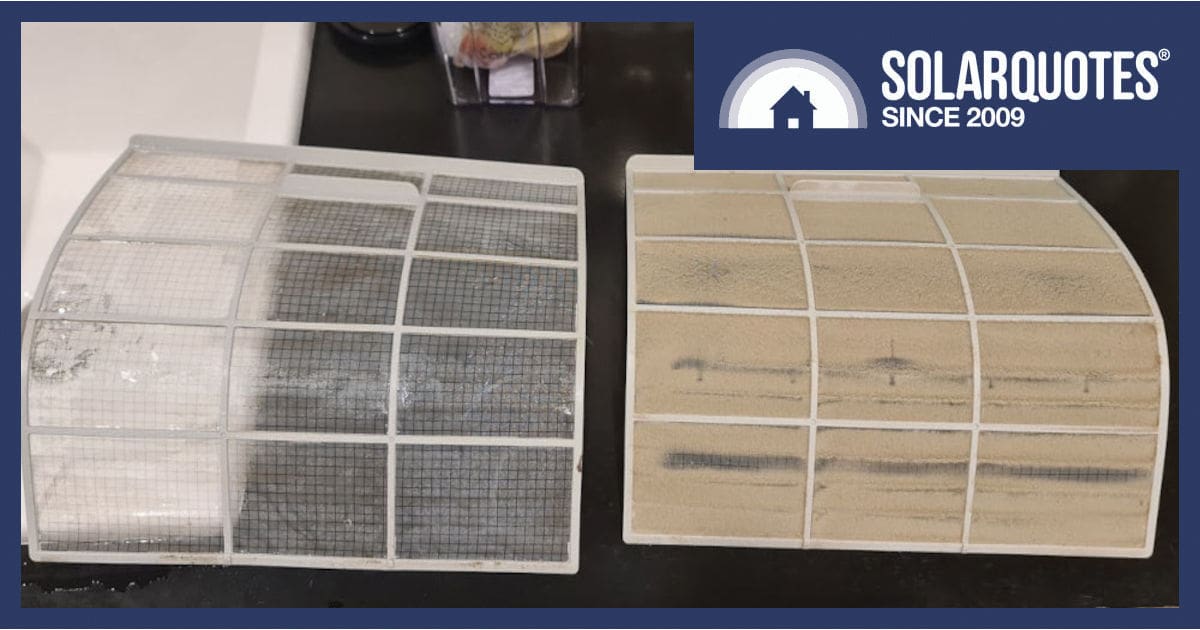
Winter is here, and nobody is more aware of that than Australians with a struggling reverse cycle air conditioner (RVAC). If your system isn’t keeping you warm, here’s what to do to get it humming.
Reverse cycle systems have plenty of benefits over gas heating – they’re cheaper to run, better for the environment, and present fewer health risks. But some people find they don’t feel quite as cozy. I saw such a complaint from a RCAC owner recently which I’ve paraphrased below:
We live in a cold-climate winter area, and five years ago we replaced our old ducted gas system with reverse cycle air conditioning. We upgraded the ducting too. On paper, the new system ticks all the right boxes — maybe even oversized slightly — but in practice, it’s just not as good at heating. The gas used to warm the house in 30–45 minutes. Now it takes hours.
Yes, it’s probably cheaper to run. But it’s not as comfortable. And while we could improve our insulation, we haven’t changed anything from when we used gas. The comparison between systems is fair in my opinion— and the reverse cycle is losing. To make things worse, defrost cycles in cold weather fire up like radiator mode and plunder your energy bill. Environmental concerns aside, it feels like we’ve taken a step backwards.
If your reverse-cycle aircon isn’t getting it done for you, there’s a few potential adjustments you can make.
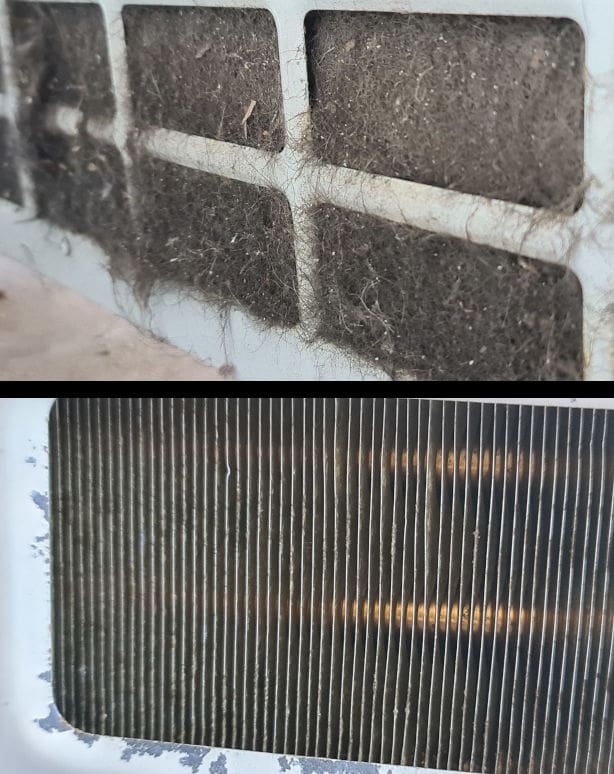
If your dog camps near the outdoor air con unit, it may be worth cleaning the coil.
Have You Cleaned The Filter?
Reverse-cycle systems don’t have the brute force of burning gas, but neither do they involve much risk. While poorly maintained gas heaters can kill people with asphyxiation, a RCAC with a grubby filter will just perform poorly.
It’s something I’ve noticed firsthand with an old “weather wall” air con unit in a rental. Built through the wall of a 1970’s house, this thing was not just badly insulated, it was in itself a massive air leak.
It was high summer and this piece of junk was noisy and did nothing, so colour me surprised when removing the inside grille revealed the mouldy mess pictured below. The evaporator coil was absolutely caked in soft, dusty, furry muck.
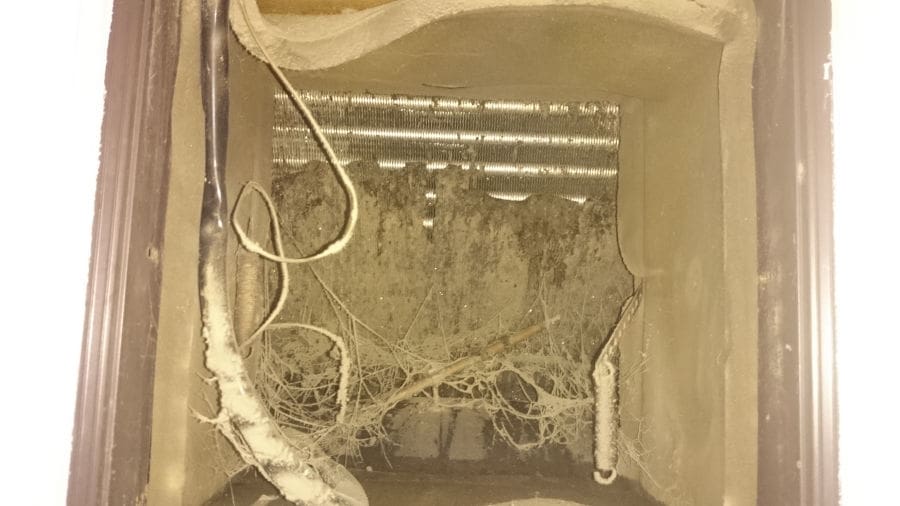
Obviously, this vile mess wasn’t going to work well. I had to take this image to show my wife what I’m willing to do for the team…
Once cleaned, the air conditioning did work, but in reality it was still just an oversized window rattler. Cleaning the filter on a more modern ducted or split system can make just as big a difference.
With less power comes great responsibility, because increased efficiency means keeping things clean is critical to home comfort.
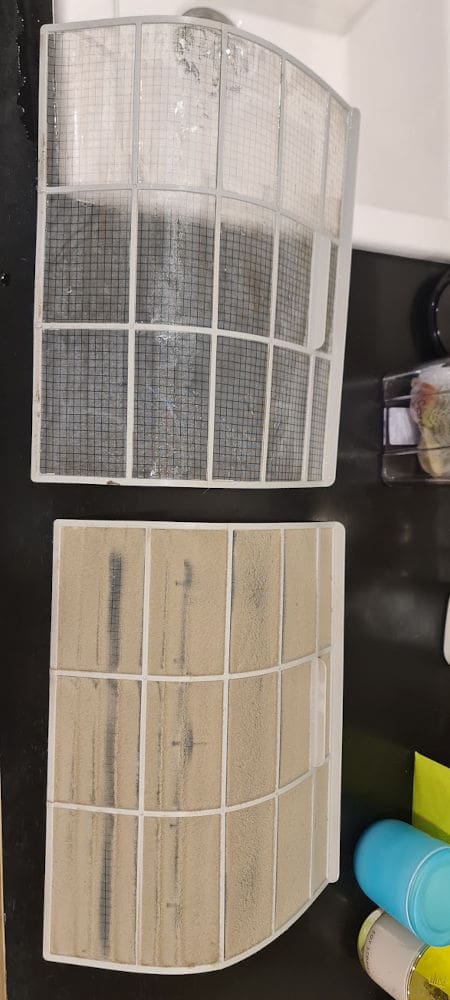
Chalk and cheese, but cleaning filters in the sink is a breeze.
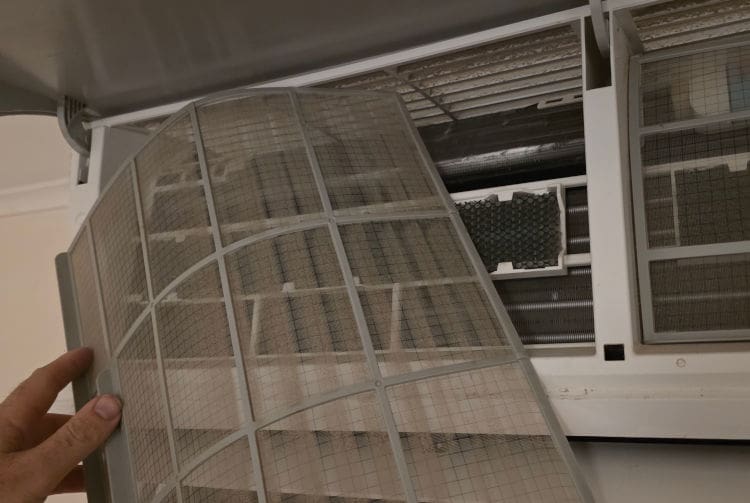
Dust is beginning to build up on the intake louvres and the screen.
Cleaning A Split System
Split systems and ducted RCAC systems are different beasts, with their own cleaning requirements and challenges.
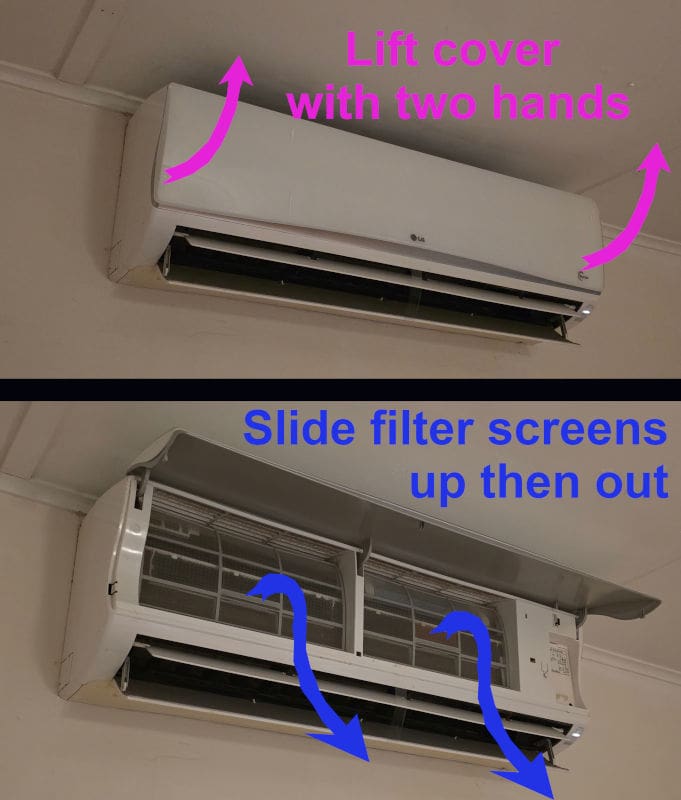
Cleaning your average split system RCAC is very straightforward.
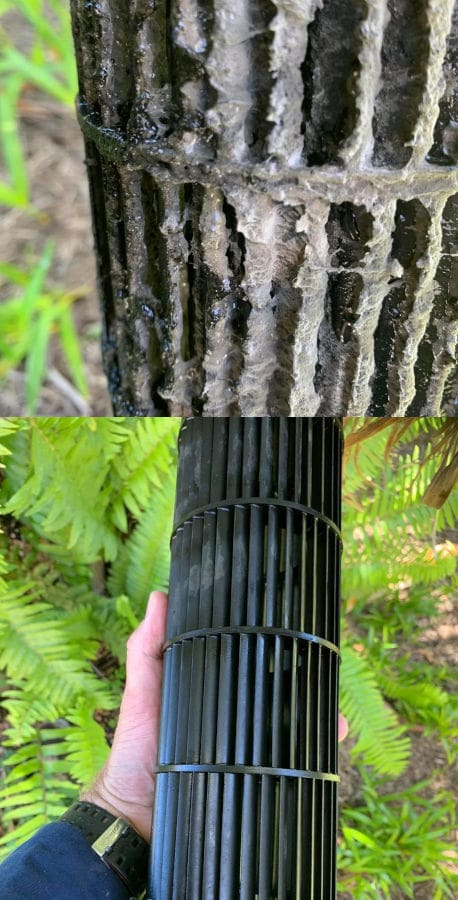
This is a tangental fan from a high wall split system air conditioner, demonstrating that it pays to make sure the condensate drain is clear.

If your split system is spitting water in summer it may be because the drain line is blocked by grass growth from outside.
Ducted Systems Can Be More Complicated
Long runs of ductwork lose heat quickly — especially in the roof space — and they don’t let you fine-tune room by room. That’s why many energy nerds prefer split systems. They’re more efficient, easier to maintain, and they heat only the spaces you’re actually using.
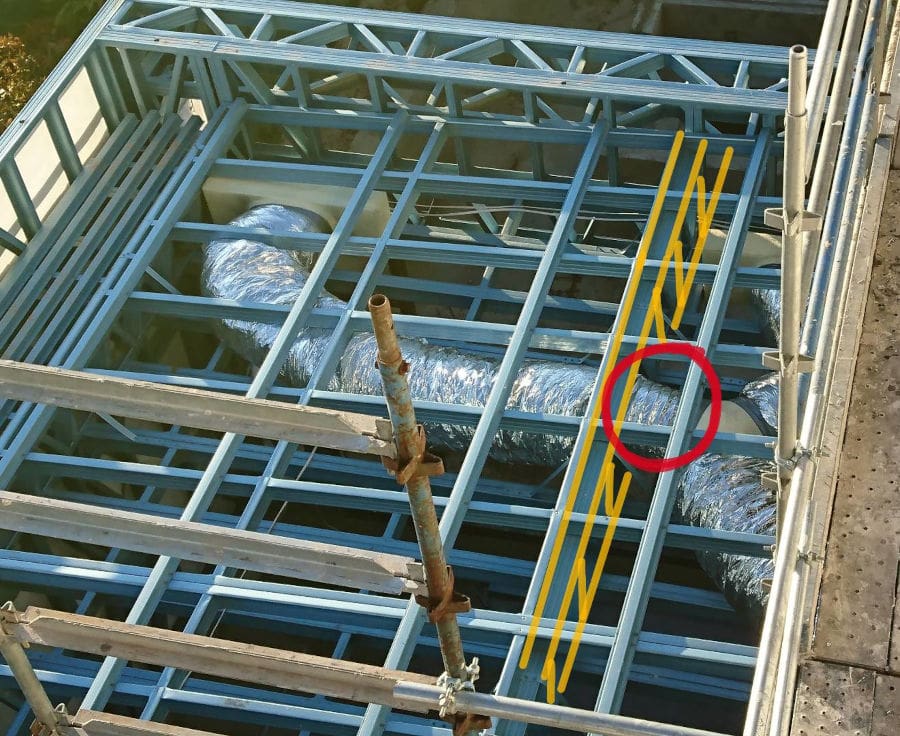
The truss highlighted in yellow was restrictive in size, hence I watched as the dodgy air contractor stripped the insulation off this section circled to make it fit through. With a flat roof, metal frame and western sun, this will be horrendous.
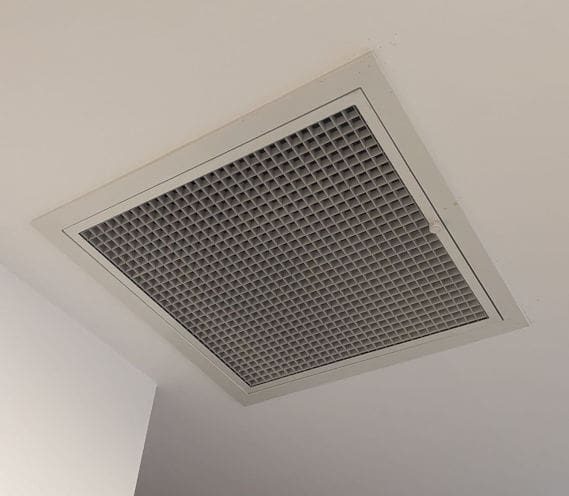
The return air filter for ducted air conditioning. Undo the thumb nut, swing it down and clean it gently with a hose or vacuum cleaner.
Reverse Cycle Isn’t Weak – It’s Different
Nobody’s pretending reverse cycle has more grunt than a gas burner. It doesn’t, and a direct comparison isn’t really fair because these are different systems using different technology.
To make an analogy, it’s like comparing electric cars to petrol ones — an EV is a fundamentally more efficient device but you can’t expect it to do precisely what a petrol one does because they’re not the same.
They need a different mindset because you can’t refuel on the highway in 5 minutes, but 20 minutes for a coffee to get you to 80% does pretty much the same, without wasting time on 100% charging.
Hold On To Your Heat
If your car was leaking petrol, you’d fix it in an instant. Heat’s no different — it’s just invisible without a thermal camera.
Improving the insulated envelope of your house should be the very first step because it makes things more comfortable, even without turning the RCAC on, plus it improves efficiency too.
Most Australian homes are built like sieves — draughty, under-insulated, and full of cheap oversized single-glazed windows in metal frames that bleed heat. Using a gas or wood fire, the flames in some cases can simply overcome the inefficiencies.
But with RCAC, those problems become more evident. Suddenly you notice the cold air pouring through gaps, the rooms that never feel warm, the whole house as a system is struggling.
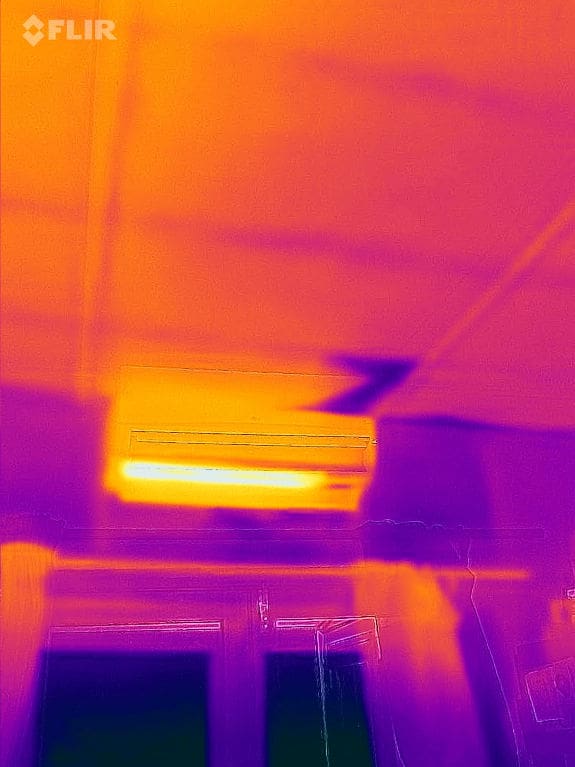
Misplaced insulation batt leaves a cold (dark) patch on the ceiling above this RCAC while it’s heating the room.
A Warm Welcome Home
For home heating the trick is to program the RCAC to come on earlier in the day, so the house is warmed up before you get home.
Instead of flogging the heating between 6 & 7pm, give it some time to do the job when the sun is out, which if you have solar means the electricity is basically free. What you’re aiming to do is get the thermal mass of the house under control.
Once you walk in the door to a pleasantly warm house, you can decide to throttle down or even switch off the heating.
Thermal Inertia Is A Thing
My first house was a 1950ish double brick number, with evaporative air conditioning, leaky sash windows and no insulation in the ceiling whatsoever.
There were times I would rock home at 6pm, it was cold and dark, and the house was even colder because nobody had been home all day.
My quick and dirty solution was a 300mm inline fan which sucked air out of the roof space and pushed it inside through the air con ducting (The evap unit was sealed up). There was no fancy thermostat, just a timer which ran the fan from 10am to 3pm.
On average it was warmer in the roof during the day, and I would find the house warmer inside when I got home.
By using the warm air from the roof, I got the internal brick walls, the thermal mass in the house, warmed up for free. Then the RCAC didn’t struggle so much because it had a higher base to work from.
The system I’ve described here is one you could buy as a package from Perth. It was featured on the TV and even had a nice temperature “control” panel. Instead of a dumb timer, it measured the temperature in the roof and when it was 5ºC hotter above the ceiling, the fan came on to move that heat inside. Sadly, this system is no longer available, but I’ll try to resurrect a DIY guide if I can.
Defrost: The Silent Comfort Killer
One of the biggest complaints from cold-climate users, including our RVAC owner at the top of the article, is the dreaded defrost cycle. Just when you need warm air in the early morning, the system shuts down to protect itself — because frost has built up on the outdoor unit.
This is normal, but annoying when (assuming they’ve installed the right system to begin with) a resistive element kicks in to consume a lot of power and fend off the frost.
It’s also another reason to run the system early to maintain steady temperatures. If your unit is constantly battling ice, it’s a sign the system is under strain or the outdoor unit isn’t in an ideal spot.
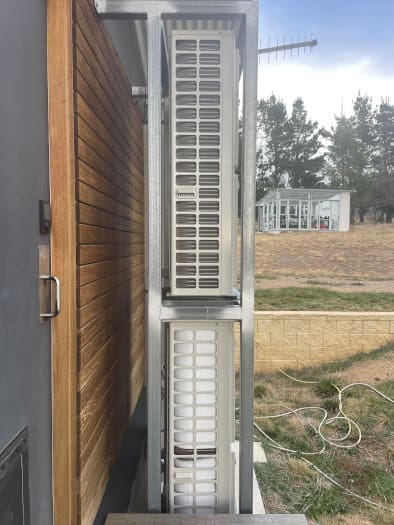
RCAC unit frozen over
In God We Trust. Everyone Else Brings Data.
If you’d like a different perspective, follow Nate the House Whisperer. He is very good at making heat pumps work in challenging conditions across a range of climates.
Careful planning and real-world data means RCAC can work brilliantly — even when it’s snowing — but only if you treat it as a system, not a standalone box. That means thinking about your house as a whole: insulation, air sealing, zoning, timing, and yes, maintenance.
Bottom Line
People are often unsure of change and see any criticism of RCAC as plenty of reason to stay with pretty expensive and polluting heaters. However once they move to efficient heating, it exposes how much other work needs to be done to overcome the thermal deficiencies.
RCAC doesn’t always hide the flaws in your home the way burning things does. So if it feels like a downgrade, the solution isn’t necessarily a bigger unit — it’s a better setup and smarter use.
And yes — you’ve got to clean the filters.
For more, read our detailed guide to air conditioning.

 RSS - Posts
RSS - Posts


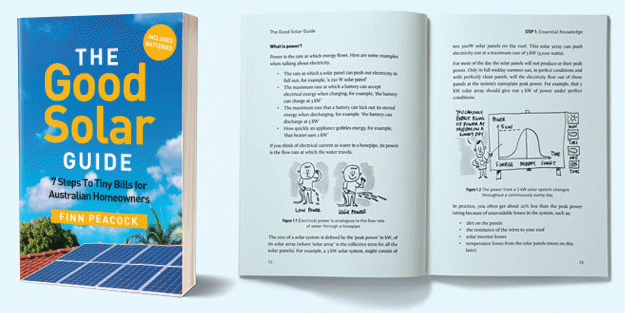
Regardless of all you have said in this article reverse cycle airconditioners while more efficient overall just dont deliver good performance when the air temp drops really low outside. That is when you most need it they cant deliver.
I agree with the person. Gas heating in winter is farm more cosy. I think floor mounted heaters with radiant heat and air rising are the reason, compared with heating overhead. After all hot air rises doesnt it.
If you have ducted AC, when using it to heat, ceiling fans are a must have. New house, last winter no ceiling fans vs ceiling fans now on lowest setting is chalk and cheese.
House heats up quickly with warm air being pushed down on you in no more than 5 mins. Outdoor temps down to low single figures.
No ceiling fans is fine for cooling, the cold air drops straight down as it is more dense.
We have a large single story house with high ceilings using around 2kW per hr to keep at 22 C after the first 30mins.
My house is toasty warm using nothing but reverse cycle. If anything it feels warmer than the old gas heating because it used to blow air so hard through the ducting. And I live in the town with Australia’s coldest average temperatures. Plenty of sub-zero stuff here, including this week, and the house was toasty warm throughout.
Nothing heats like gas
These were designed for cooling
Heating is a bonus . Its a climate con
Its the filters
Cleaning a filter is not going to fix its heating ability.plits just dont have the heat value gas does .full stop .
Dont get sucked in
Hvac contractor
Have had both, and am sitting in a house where it’s snowing outside right now, and it’s toasty warm. The warmest my family has ever been. With HVAC.
Heat pumps are fully reversible. A friend of mine lives in the Arctic Circle and also uses a split to keep toasty warm.
I haven’t paid a cent for heating in over 3 years. if we’d stuck with gas it would have cost us thousands to stay warm.
Hi Ant,
Nothing poisons you and your kids like gas.
https://www.solarquotes.com.au/blog/gas-cooking-benzene-children-mb3180/
And as a contractor you might want to sharpen up your knowledge before dispensing any more advice.
https://www.solarquotes.com.au/blog/how-to-get-off-ducted-gas-before-it-sucks-up-all-your-money/
And as far as the con goes, it’s the fossil industry that’s been conning us for well over 50 years.
https://www.abc.net.au/listen/programs/scienceshow/the-science-show-celebrates-50-years/105658842
ian: – “Gas heating in winter is farm more cosy.”
Where do you think your affordable, reliable, sufficient-for-your-needs gas supply is coming from in the coming years/decades, ian?
Per AEMO’s Gas Statement of Opportunities: March 2025 – For Australia’s East Coast Gas Market, in Figure 27: Reserves and resources: 2024 GSOO versus 2025 GSOO:
Key Data (as at 31 Dec 2024) for the Australian east coast gas market:
2024 actual production: _ _ _1,962 PJ
2P developed reserves: _ _16,982 PJ; reserves-to-production (R/P) = 8.7 years
2P undeveloped reserves: 14,987 PJ; R/P = 7.6 years
2C resources: _ _ _ _ _ _ _37,915 PJ
The 2P reserves estimate reflects statistically that there should be at least a 50% probability that the quantities actually recovered will equal or exceed the sum of estimated proved plus probable reserves.
Gas is only going to get scarcer and more expensive.
We have oodles of gas reserves just need government and greenies to free it up.
Gas is methane, methane is poison
I have ducted and regularly clean the return air filter material. I feel like there must be some maintenance required for the outdoor it but have not been able to confirm. Is there something I should be doing to it?
In the 1990s I rented a very old weatherboard and timber lined, uninsulated house at the top of the Blue Mountains in NSW. Minus 6 c some winter nights. There was a modern combustion stove but it failed to heat the kitchen, let alone the other small rooms. I bought a thermometer and at shoulder height the temperature was 25 to 30 Celsius, but still cold draughts from windows and doors. One night I noticed a nail had emerged from the very high vaulted ceiling, got 2.1m stepladder to nail it back in and the temp there was 30c. Bought a metal blade ceiling fan, strengthened ceiling. Running cost equal to 60 watt light globe, halved wood, stopped all draughts and 30c at seated height and warmed all rooms.
Found your same result of halving wood usage and better and even heating with wood slow combustion fire, by just turning on a pedestal fan facing the internal chimney and ceiling, near the flue the ceiling temp can be 70 Deg C,…all racing through the insulation.
Magic how much difference it makes,… and to spread the heat (or cool in summer) put on a distant exhaust fan to throw out the low heat (or low cool left as the air passes through the house away from its source.
My reverse cycle ac works really well and apart from cleaning the filters I haven’t done any maintenance on it in 10 years. The fan and inside looks a bit grotty though which makes me think the drain might not be working so well. I see adds on Facebook about air conditioner unit cleaning but I’m not sure if they’re legit. Any tips on how to get it properly cleaned?
If you have ducted AC, when using it to heat, ceiling fans are a must have. New house, last winter no ceiling fans vs ceiling fans now on lowest setting is chalk and cheese.
House heats up quickly with warm air being pushed down on you in no more than 5 mins. Outdoor temps down to low single figures.
No ceiling fans is fine for cooling, the cold air drops straight down as it is more dense.
We have a large single story house with high ceilings using around 2kW per hr to keep at 22 C after the first 30mins.
Great piece Anthony, thank you. Thermal mass is so crucial, I’m a broken record on it with my friends. I heat the house all day when we’re not home, with solar, and the splits barely need to break a sweat all night as a result. We also invested in quality windows and frames.
An air con engineer friend said he despairs of people treating reverse cycle units as ‘heaters’ and ‘coolers’. He said they run much more efficiently maintaining a constant temperature throughout the day and night, also tapping into the building thermal mass. They ‘condition’ the air, thus the name, rather than using them only to give you huge bursts of heat and cold in extreme weather conditions. He uses the analogy of wanting a cold drink in summer, you don’t come home and chuck a warm drink in the fridge and expect it to be chilled inside 5 minutes.
We trialled only using the reverse cycle in winter but found it dried the air so much we had to get a humidifier as well. The reverse cycle feels uncomfortable especially if you are in the breeze zone which cools you down like a fan, even on low setting. I read some research which indicated that the temperature of the returning air into the unit is a crucial factor which is impacted by the temperature of windows, walls, and ceilings. Now we use the gas heater as well for an initial boost then let the reverse cycle take over.
Interesting topic. I wonder how electric floor coil heating in slab in perhaps main room would give some thermal mass and heat during day taking load off reverse cycle air-conditioning. Cost comparisons would be interesting.
I guess a new-fangled Heat Pump HWS would now be the most efficient source of hot water for in-floor heating systems?
Hi Clive,
Hydronic heating using radiators needs a reasonably high temperature, many were designed to use steam. However floor heating is more heat pump friendly to the best of my knowledge.
Heat rises. If feasible, include floor or low wall vents as separate zones when installing ducted A/C. Works far better than trying to push cold air down/out from ceiling vents.
Another tip when using a high wall split for heating… set the vertical fan swing angle closer to downwards than horizontal. That mixes the hot and cold air better, thus mitigating the ‘hot air rises’ problem.
But yes, a ceiling fan is best.
I think circulating fans may actually be best, like the ones Vornado make. I have a small one of those I run in my lounge room at the same time I have the split going, pointing towards the ceiling, you can directly feel the warm air circulating to every part of the room. The room feels significantly warmer, without changing the heat input from the split. Circulating fans also avoid direct blowing onto you, they create micro-vortexes throughout the entire space.
My home’s reverse cycle air conditioner uses 5.5 kWh of electricity, which is the most power-consuming appliance in my house. Is it power-saving? Looks like this saves more energy https://www.bunnings.com.au/arlec-2400w-micathermic-heater_p0163848 , for 4 person family
Hi Carfield,
RCAC is often rated for heat output and when the coefficient of performance can reach 4:1, then 4kW of that heat is drawn from the air outside, while only 1kW of electrical energy is used to compress the refrigerant gas that is used to pump that heat from the outside to the inside.
A 2.4kW resistive heater will draw 10 amps from the wall, 5.5kW equates to 24amps, more than a third of the total supply available to many houses.
As Anthony says, I think you’re looking at the quoted output of the reverse-cycle unit rather than input. I can run 6 or more splits at one time and barely get above 2kW of input power. I also use the thermal mass of the building, if I were to let the house become freezing or baking hot and then out all the splits on at once, I’d get a higher power draw, but even then I don’t remember ever going above 5kW, even with multiple splits on.
Thanks Anthony for the reminder that there are many balls in the air when it comes to managing space heating/cooling in a house – which is where so much of our energy goes during the extreme temperature times of the year, and in the winter the cheap daytime (solar generated) energy is needed at night!! Good insulation, double-glazing and thermal mass are often rightly cited as avenues to pursue but I have not seen any interest in or discussion of the use of phase change materials in buildings for passive thermal control. Is this ineffective, impractical or uneconomic or simply never considered?
Cheers, Ralph
Hi Ralph,
Phase change materials are fascinating but I haven’t looked into them a great deal. Wool is arguably a phase change material as it will absorb and release moisture when used as insulation, you just have to stop the moths eating it.
Phase change is the reason the yanks still rate air conditioners in tons though. They’re relating to the energy needed to create a ton of ice AFAIK.
Hi Anthony
By phase change material (PCM) I was actually thinking of the use of high specific heat materials with a melting [hence phase change] temperature range within the human “comfortable temperature” range. This enables heat energy transfer without change in (comfortable) temperature.
Hi Ralph,
I’m familiar with the concept but when I made a cursory look into ceiling insulation, phase change material was available but was also expensive compared to the standard fluff.
Would love to hear what you have found.
I recently built a tiny house on wheels for my daughter and she wanted wool insulation. We couldn’t source anything in Australia and ended up having to get it in from New Zealand. Not cheap but lovely stuff to work with.